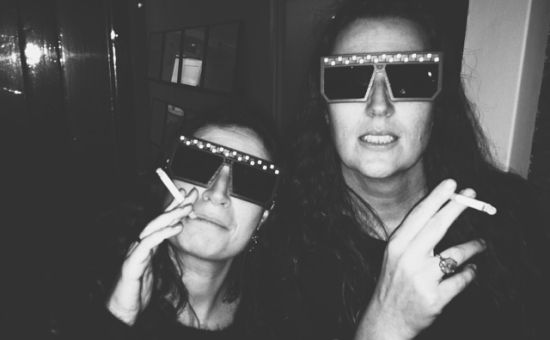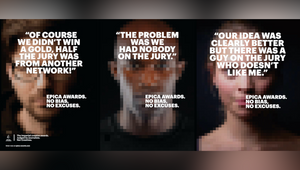
5 Minutes with… Sandrine Huijgen

After years working as global communications director for Phillips and, more recently, Heineken, Sandrine Huijgen decided to follow her heart and her creative passions – leading to a career change that many marketing people can only dream of. As a client, Sandrine had been involved in ambitious and daring projects, like Heineken’s ‘Dropped’ – but what she really wanted was to get more deeply stuck into the creative process. A copywriting course and mentoring from her erstwhile collaborators, Sandrine found herself at Amsterdam-based agency Cloudfactory. She’s been there for a year and a half, working with creative partners Jessica Kersten and Olivier Teepe and CEO Sandeep Chawla.
Recently she’s been working on the launch of a new Heineken cider brand and a visceral film about feminism and femininity for Dutch fashion designer Marlies Dekkers. LBB’s Laura Swinton caught up with Sandrine to find out more.
LBB> You’ve been at Cloudfactory for a year and a half – what is it about the agency that makes it unique?
SH> I joined Cloudfactory for two reasons: Jessica Kersten’s offer to join her as a creative partner, and to reinvent what an advertising agency could bring to a client’s creativity! The desire to reinvent herself was what drove Jessica to leave traditional agencies to co-found Cloudfactory, and it’s precisely what was driving me.
Together with our two other partners, Olivier Teepe and Sandeep Chawla, we have taken Cloudfactory to a new level. We kept its strong love of craft and added a few more things that were important to us: co-creativity with clients (I know from experience that clients can be passionate and useful in the creative process if they are welcome!), story-doing rather than storytelling (let’s do more and talk less!), and finally creativity for good. We don’t want to look back and think ‘God, I have only made TVCs to sell stuff that people may not even need.’ We want to leave a legacy and we have a dream: what if we can encourage big brands to spend their marketing budget to do good? Wouldn’t people love them for it? Can we help brands achieve this with our creative work?
LBB> Before joining Cloudfactory you worked on the brand side of things – what prompted you to jump the fence into the creative agency world?
SH> I was incredibly lucky in my career, having worked on great projects with great creatives who were very open to working organically with me as a client. Jessica was a prime example of this when I was her client, and so were the guys at Wieden+Kennedy Amsterdam: Mark Bernath and Eric Quennoy and Thierry Albert and Faustin Claverie.
They were not just brilliant but also cool with including me in their creative process. I felt like a team with them and started to feel more and more pulled in the direction of doing the creative myself, not just fuelling it. I planned carefully, taking classes in creative writing, co-creating on a few smaller projects. I had to face the incredulity of a few people - how can a client become a creative? - and I took the jump and so far have not fallen flat on my face! Maybe because I bounced off a cloud?
LBB> And how did you find the transition?
SH> A rebirth!
I still have to deal with my insecurities but Jessica is a very confident partner, confident in her own talent but also so generous with her trust in my developing skills. We work well together because having been on the other side, I instinctively know what the client wants and can decode signs that she might not pick up.
And of course, I had the trust of my Heineken ex-boss and colleagues who have given me a chance as a creative to work on their projects. This is an invaluable way to start a new agency!
LBB> What advice would you give to marketers and corporate comms people thinking about making that move?
SH> Do it! Prepare well, and find the right partner, someone who does not want to play by the rules.
LBB> The most recent project to come out of Cloudfactory was the raw and provocative film for Marlies Dekker. Why was it the right approach to tackle the film in such a visceral way?
SH> When we started to work on the project Jess and I were struck by something: we were ashamed to call ourselves feminists. Then we looked up the definition and realised that we had to call ourselves feminists without a doubt. It’s not easy to stand up for yourself and claim your rights, as a woman or as a minority. We liked Marlies’ unapologetic attitude a lot, and quickly agreed with her that the film had to be raw and dark because it is not a fairy tale to be a feminist, it can be hard and brutal sometimes. But the film also had to be beautiful and sensual, because for us, there is no choice to be made between being feminist and being feminine. We created the feminine feminist concept for Marlies Dekkers and firmly believe that the brand can use it as its mission through everything it does.
We were very lucky to co-create the film with Daniel Nogueira as director. He completely embraced our vision and made it as raw and beautiful on film as we had in our imagination – I am forever grateful for his drowning scene idea!
He gathered an amazing team, such as Jelani Isaacs (producer) Jasper Wolf (DOP), Jeroen Echter (set designer) and Time Based Arts (post). Without him and his team, we could not have managed such a film. It is even hard to believe it has been shot by a guy!
LBB> The film feels like a very creatively open and honest collaboration between Cloudfactory and Marlies Dekkers. It also feels like you’re very much interpreting her own personal vision. What was that collaboration like?
SH> Marlies Dekkers is a wonderful brand because it is alive and kicking in one woman’s heart! How often do you have the chance to work with someone who embodies the brand, who has put so much of her personality, history and life into it. We were inspired by her attitude and her story from the start, and agreed to work together as a creative team. Marlies wants to be a leader of the feminist third movement, she creates her collections wanting to support women and help them affirm their power. She has done this for years. We only channelled her desire into a clear and direct creative concept, feminine feminist, that now guides the company behind the woman. And we brought it to life in a manifesto film with Daniel.
LBB> The film deals with identity politics and some of the subtleties surrounding feminism and femininity – two concepts which are often portrayed as being opposite. What was it like for you having the freedom to explore such complex ideas on behalf of a brand?
SH> Wonderful! It has been a great deep journey into ourselves as women first and as creatives afterwards. Jessica and I have both worked in quite masculine worlds since we started our careers and it has not always been easy. But we also felt that we have never had to give up who we are, we both have our styles, our sensitivities and we feel that they are a strength, not a weakness. Being a feminine feminist can help you achieve your dreams. We actually never felt we were working for a brand, but working for an ideal for half the population out there! Creativity for Good rules!
LBB> What other projects have you been involved in recently that have really excited you?
SH> So many! We have worked with the Heineken brand on sustainability, putting their sustainability report on a bottle. We have also contributed to the launch of Mort Subite beer in France. We are now working on creativity for good with a Heineken cider brand, as well as creating a whole new world for a craft cider. We are incredibly lucky to have clients that want to co-create with us, and see how creativity for good can be cool if well crafted.
LBB> Who are your creative heroes and why?
SH> Mark and Eric at W+K are my creative heroes, because despite being ECDs they never sold out. They still have the fire and are uncompromising at making great work. I am also a huge fan of Fredrik Bond, the director, who is as excited on projects now as my eleven-year-old was at Universal last summer. I love working with people who never ever lose their fire!
And my creative psyche is populated by all these French writers I worshiped when I was growing up, Zola, Hugo, Stendhal, Pennac, and more recently Reinhardt.
LBB> How do you overcome creative block?
SH> Jess and I unblock each other. She is super visual and I am more conceptual. She always amazes me with images that she finds. They trigger completely different perspectives in the way I look at a brief. We also find inspiring locations around town and talk a lot. And we believe in Serendipity! There is always something around us that makes look at each other. ‘See it was meant to be!’
LBB> Cloudfactory is interesting as it is part of a cool bloc of Dutch independent agencies that have a very global mind set, bridging that gap between Amsterdam’s hip international agencies and the agencies that are more focused on the local Dutch market. I was wondering what your thoughts were on this?
SH> I have never looked at it that way but it is true that we are kind of a hybrid. We think that we are lucky to be small and agile so we have been able to reinvent ourselves freely and use our past creds to be able to prove our worth. We like and are used to working with international clients, but also enjoy the nimbleness of smaller local clients.
I think Amsterdam is definitely a great place for creativity. Lots of big international companies but also very active creative communities. We are happy to be a small fish in the pond doing what we love and finding clients who want to experiment with us on approaching marketing differently.
LBB> Before heading to Cloudfactory, you were at Heineken and oversaw some incredibly creative and brave projects – what were the biggest lessons you learned during that time?
SH> As I said before, I learned so much by seeing how it was done by the best in the industry. I also learned to trust my instincts and not be afraid to guide creatives and also my bosses where I wanted to go. Finally, I learned to respect creativity: it looks so easy and simple, like anyone can do it, but it takes a lot of work, skill and most of all, heart to do it well. Heineken gave me so much freedom and trust so I could grow. I would not be where I am today without the seven years I spent there.
LBB> What can we expect to see from Cloud Factory in 2016?
SH> A big campaign for a cider brand for many markets around the world is in the making. We are doing it exactly as we dreamt, so super excited about that. You’ll hear more about it soon.
We have a couple more out-of-the-box projects with Heineken both on a company level and in the craft cider category. We are also working for responsible fashion with a start-up called Rewear. And we’re having interesting conversations with potential new clients.










